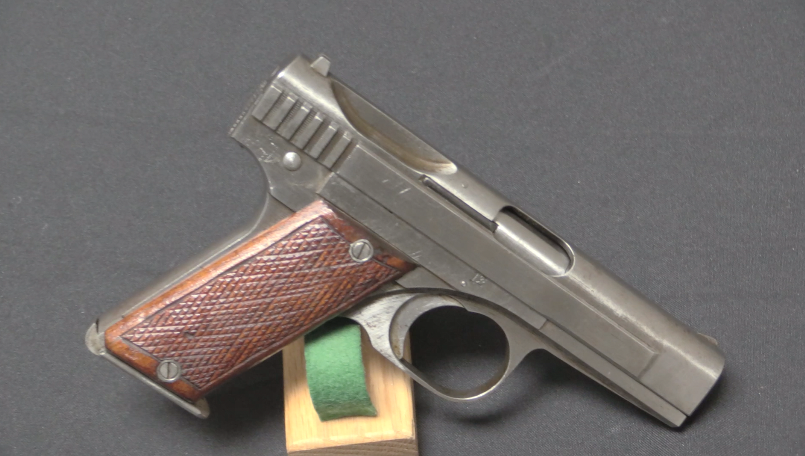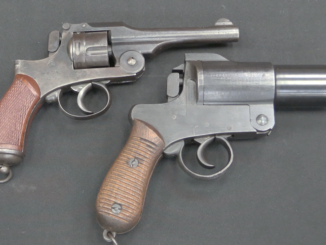This is Lot 2086 in the upcoming October 2019 Morphy Extraordinary auction.
Before and during World War Two, the Japanese used a variety of training rifles and machine guns in both formal military instruction and technical schools to teach basic military drill. These guns were used for teaching basic drill skills, and were built to use wooden-bullet blank ammunition instead of regular cartridges. This greatly simplified arranging safe facilities for the training.
The training machine guns were intended to replicate the basic handling of the Type 96 and Type 99 Nambu guns, with similar bipods, grips, stocks, sights, and top-mounted magazines. Mechanically, however, they are simple tube receivers with blowback open bolt firing mechanisms. Some, like this one, have dummy gas systems so that bayonets can be fitted as on real machine guns and so the gas adjustment procedure can be pantomimed. The parts are held together by simple screws for simplicity of production. At least six different companies made training machine guns, and they are found in a wide variety of configurations – usually without any identifying markings. This example is one of the more complex designs and also a very nice-condition example. Unfortunately, the magazine is missing (as they usually are).
WARNING: DO NOT FIRE LIVE AMMUNITION IN THESE GUNS! They are intended only for wooden-bullet blanks, and live ammunition will severely damage the gun and potentially injure the shooter. Also, be aware that these guns are considered machine guns by Federal law in the US, and are illegal if not registered under the NFA.




Ironic that a resource-poor island nation not only made the most elaborately machined MGs of the war, but carried over nearly all that intricacy to the unstressed parts of a training toy.
They could easily have put a STEN-like steel tube and barrel (maybe a few other stressed / wear parts too, like the bipod legs and mag catch) into a die-cast zinc shell with no real loss of functionality or tactile realism.
On the other hand, delivering good-looking training utensils might inspire trainees to believe in might and war-preparedness of own country.
I agree, soldiers want to feel like they’re holding a MAN’S weapon, not a cheap two-dollar toy. HORSES FOR COURSES, NOT COURSES FOR HORSES!
Which would you actually issue for target practice, a cheap “toy” that a recruit could break by SITTING on it or something so good that a soldier would feel honored to have it issued to him?
Really dumb questions:
Could this system be adapted for dye marker rounds (a more serious paintball)?
Is there a way to make sure only wood balls were loaded? I hope modifying the magazine and receiver would prevent live rounds from getting in!
Where’s the user manual when you need it?!
Not dumb questions: I’m sure the tubegun core construction of the weapon would leave you ample “canvas” for such experimentation, and that you could easily (and subtly, so as not to ruin the outward appearance) block the inside of the magwell to take only marker rounds.
On the OTHER hand, thousands of dollars and all the NFA hoopla (plus remembering your tax stamp / Get Out of Jail Free Card for every match) for a paintball gun? The same factors that could have helped the Japanese make a blank gun without all that machining would make it even simpler to replicate yourself as a marker, with none of the live-gun hurdles.
Personally, I’d make an insert for .22LR – the most fun (and only affordable) way to shoot full-auto.
Why not simply buy a an AirSoft and use marker rounds?
https://www.youtube.com/watch?v=MvKhjWRNTvI
In some locals the AirSoft is an illegal weapon, but the feds haven’t yet regulated AirSoft machine guns the way real machine guns are regulated. The Nevada Army National Guard used AirSoft M16A2 rifles, M4 carbines, M249 light machine guns and M9 pistols for force-on-force and close combat simulations.
Remarkably similar to the Australian Owen 9mm SMG in many respects. Chambered in 9 x 19mm with a proper rifled barrel, it would probably work perfectly safely with live 9mm pistol rounds and go on shooting almost forever.
In Small Arms of the World (9th ed.) Smith states that at least three variations of these types of weapon were captured in Korea, being used by both NKPA and Chinese PLA troops with live ammunition.
I’m wondering how many were found in pieces, with a dead gunner behind them with the bolt sticking out of his face as with a Ross straight-pull rifle.
cheers
eon
Several sources (that I can’t locate right now) allude to combat use of wooden bullets by Japanese soldiers. Parallel platoon columns some 50 yards apart would infiltrate enemy lines and the fixed bayonet and offensive (concussion) hand grenade were used on the enemy without endangering Japanese columns to the flanks. Wooden bullets were deadly at short distances and had greater reach than bayonets–and the psychological impact of gunshots. Whether or not this was fact I cannot prove.
But there were several varieties of wooden bullets and the USA used some as well. One type was hollow and made of softwood and would shatter inside the gun barrel when fired–these were blanks. Solid wooden bullets were used to punch holes in paper targets for indoor rifle training–I have little information on these.
Today there are plastic bullets, both blanks and training projectiles. The training projectiles have possible used in riot control operations but the political fall-out is great.
https://www.outdoorlimited.com/rifle-ammo/7-62x51mm-nato/dag-7-62x51mm-ammunition-srt-plastic-training-ammo-dm18a1b1-10-grain-plastic-projectile-case-of-1-000-rounds/
I believe the red plastic training ammunition is blank and the blue plastic training ammunition is for indoor range practice. Both can be lethal at muzzle contact distance. At ten meters the plastic bullet still has enough energy and soft-tissue penetration to inflict a lethal wound. I’ve fired some of the plastic ammo and I needed to swap bolts in my M16, the recoil and report were lighter, and I had to zero for the plastic ammo and then return to my original battle sight zero.
https://www.logsa.army.mil/psmag/archives/PS2008/663/663-22.pdf
Using these training machine guns with solid wooden bullets is a possibility, but unlikely even as a last ditch measure. Machine guns are weapons used at a distance. There’s not much distance with the modern plastic bullet training ammunition.
When these wooden bullets were encountered in combat areas, American soldiers flipped out. It was thought that these bullets were intended to inflict traumatic wounds. More probably these were hollow-bullet grenade launching blanks–there were one or two rifle grenade launchers in every Japanese “light machine gun section” (“rifle squad” equivalent). Even so, perception rules. I wonder how many Japanese rifleman/grenadiers were summarily executed for possession of grenade launching blanks?
https://www.trailblazersww2.org/history_woodenbullets.htm
The Fog of War makes for some strange things. Perhaps the NKPA training devices were captured in NKPA “garrison” locations and had been used for full-dress rehearsal assaults. Poverty-stricken armies often keep anything they can lay hands on even when it’s not useful–except perhaps as a Quaker gun in a dummy fighting position. Asian troops have been known to use strings of firecrackers as distraction devices to simulate gunfire.
Besides, after lugging around the M1919A6 on the confused and chaotic Korean battlefields, a GI encountering an old Japanese training machine gun might imagine that he’s just found a super secret enemy death ray wonder weapon.
Let me add to the rumor mill–the US might have vampire soldiers and the wooden bullets…
During WW1, the Germans and Italians had special rounds with bullets made of softwood, intended for launching rifle grenades of either the rodded or cup discharger type. When striking either the end of the rod or the base of the grenade, the wooden bullet would simply powder while the gas launched the grenade on its way.
Apparently this method was adopted to allow rapid and repeated launches while feeding the launching blanks from the magazine, as neither the Mauser or the Carcano is particularly happy feeding a blank with no bullet sticking out, i.e. with the configuration of an empty case, from the magazine.
My guess is they concluded that using wooden bullets for this was cheaper and less aggravation than having special-cased blank rounds with an extended and crimped “false bullet”, as most armies would adopt in the decades between the two world wars.
cheers
eon
I wonder how hard it’d have been for the Japanese makers of these training LMGs to convert the design to fire the 8mm Nambu cartridge. If the war had continued I could see desperation designs based off these being produced to combat the allied invasion of the home islands.
Japan attempts to create its version of the Volkssturm imfdb.org
The result could have been a functioning, if overweight, sub-machine gun. At the very least such a weapon would force invaders to fight local militias seriously, as they tended to be quite vicious (Japanese civilians purportedly mob-lynched downed American bomber crews as revenge for the fire-bombing of Tokyo, especially after several waves of bombers dropped diesel fuel on the fires and the victims).
Looking for information about sbi personal banking, its functionalities ,procedures. SBI derived a single solution for this purpose that is sbi saral . Saral is simplified version of Corporate Internet Banking with default transaction rights, ideal for Single user entrepreneurs consisting of sole proprietorship concerns, micro enterprise and individual businessmen having non individual account at our branches. You can visit our website for more information.
The 7.7×58 case is almost identical to the .303 British, which I believe to be it’s origin, not the 7.9×57 Mauser. The Japanese Navy had been using .303 Lewis guns since they were British allies in WW1, and they were already making the ammunition.
Sorry, comment on the origin of the 7.7×58 was meant for the video on the Type 97 Nambu, not this training gun